While nearly a quarter of all trips under 80 km are performed on foot, the practice of walking remains overlooked in statistics and is often forgotten in sustainable mobility policies. Indeed, they treat it essentially as a recreational practice worth promoting occasionally, in pedestrian areas and for the typical pedestrian. Contrary to this approach, the workshop’s goal was to assess both the current place given to walking and the policies that would allow walking to become a truly universal mode of transportation.
The students' work confirms that:
The workshop consisted of two parts:
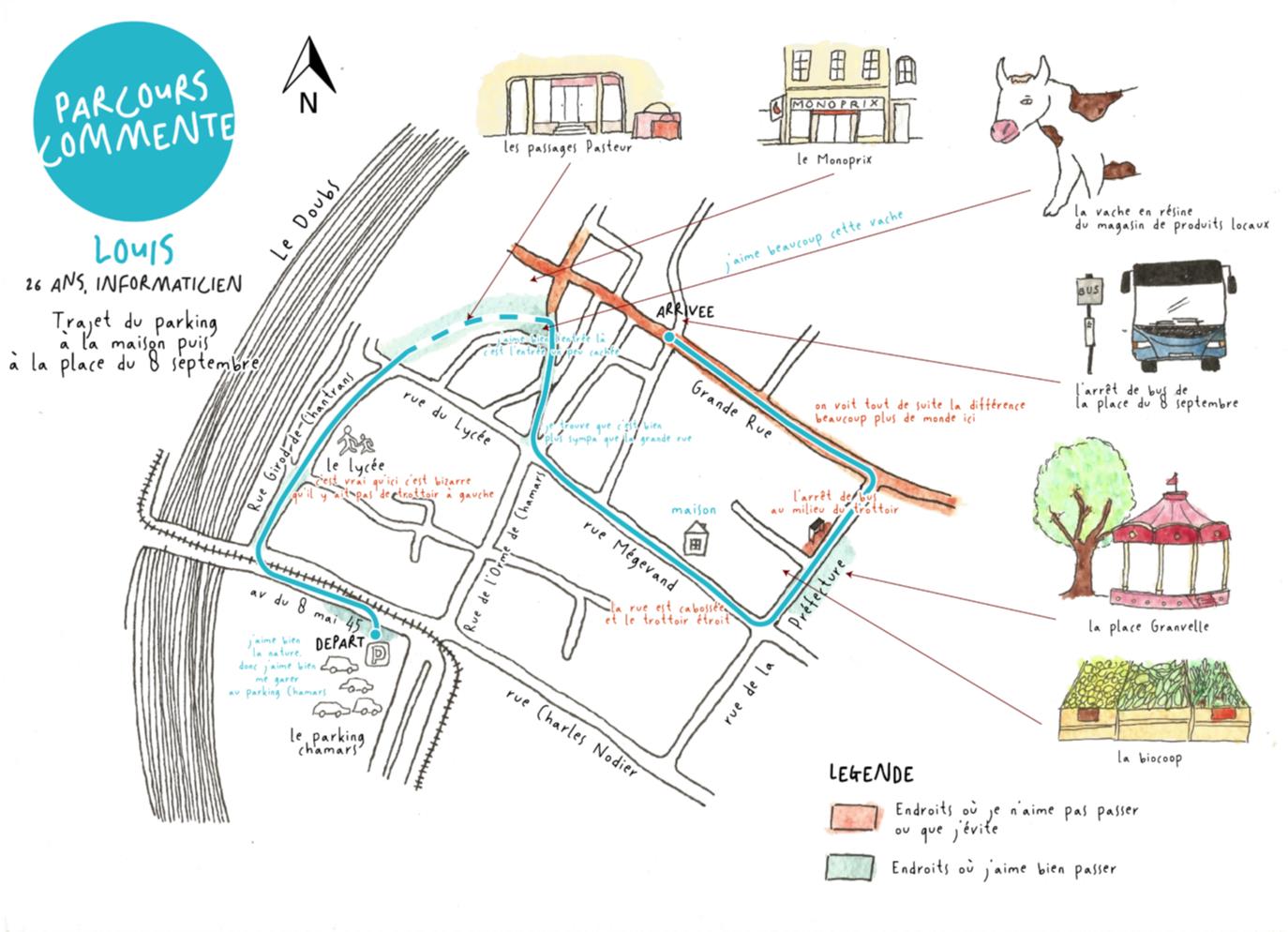
Example of a go-along interview route
Initially, the workshop studied walking on the basis of the available (partial) national and local statistical data and the analysis of public policies on walking in France and internationally.
After reaching a historically low level at the end of the 20th century, walking has been on the rise since 2008, especially in dense territories. The practices and profiles of walkers are diverse (age, gender, socio-professional category, physical health). However, it is in dense cities that the modal share of walking is the highest (32%, compared to 20% in cities of medium density and nearly 16% in cities with low or very low density) and it is mainly used for short trips (on average one kilometre, which is more than 10 times less than those by car or public transport). This is particularly the case in large urban centres where it is the main mode used for local travel.
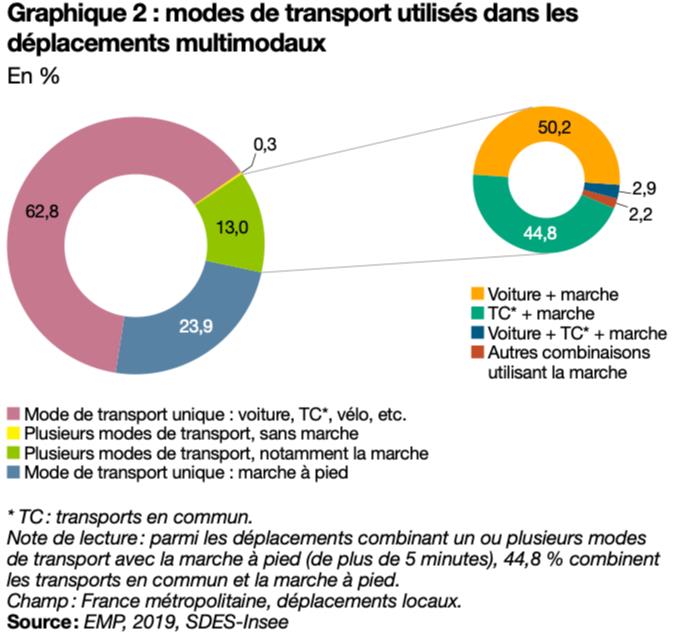
Distribution of modes of transport used in multimodal trips (in %). Source: French Ministry of Ecological Transition.
The modal share of walking increases greatly (36.9%) when multimodal journeys that include walking (13%) are factored in, which underlines the importance of linking walking networks to other transport networks 1 . Physical and emotional well-being tops the list of walkers' motivations, with 82% of respondents claiming that walking helps them to calm down and relax in the midst of their stressful day-to-day lives, and 89% reporting that it improves their quality of life 2 .
Most public policies aimed at developing the practice of walking are fairly new and remain largely overlooked or even absent in the mobility strategies of many territories. Walking is still thought of primarily as a recreational activity, a lever to make the city centre more attractive, peaceful, commercial and touristic, or even as a way to improve public health rather than as a functional mode of transport. Public policies on walking tend to focus on the pedestrianisation of delimited spaces in city centres, questioning the automobile system outside of this pedestrianised centre. Brussels is a good case in point 3 .
Yet, spaces on the periphery of city centres are characterised by interruptions and gaps in the urban fabric that are hard to cross and that expose pedestrians to many risks and dangers from car traffic. While in France, some cities such as Toulouse, Nantes, Strasbourg and Brest are striving to make their entire territory walkable by developing pedestrian networks, nothing significant has been achieved so far, other than the first Major Pedestrian Network in Strasbourg (the so-called Magistrale Piétonne). Yet walking has proven itself to be an efficient mode of travel for short and medium distances in cities such as Pontevedra and Strasbourg, as long as local authorities also implement policies aimed at reducing car traffic. Conversely, cities such as Lille show how ineffective pro-walking policies can be when they prioritise shared spaces rather than questioning the place of cars.
The students then chose to undertake a thorough study of the city of Besançon (territorial diagnosis including an analysis of its urban and mobility policies and its physical and morphological characteristics, street interviews, observations of pedestrian paths, GPS tracking, in-depth interviews, “go-along-inteviews”).
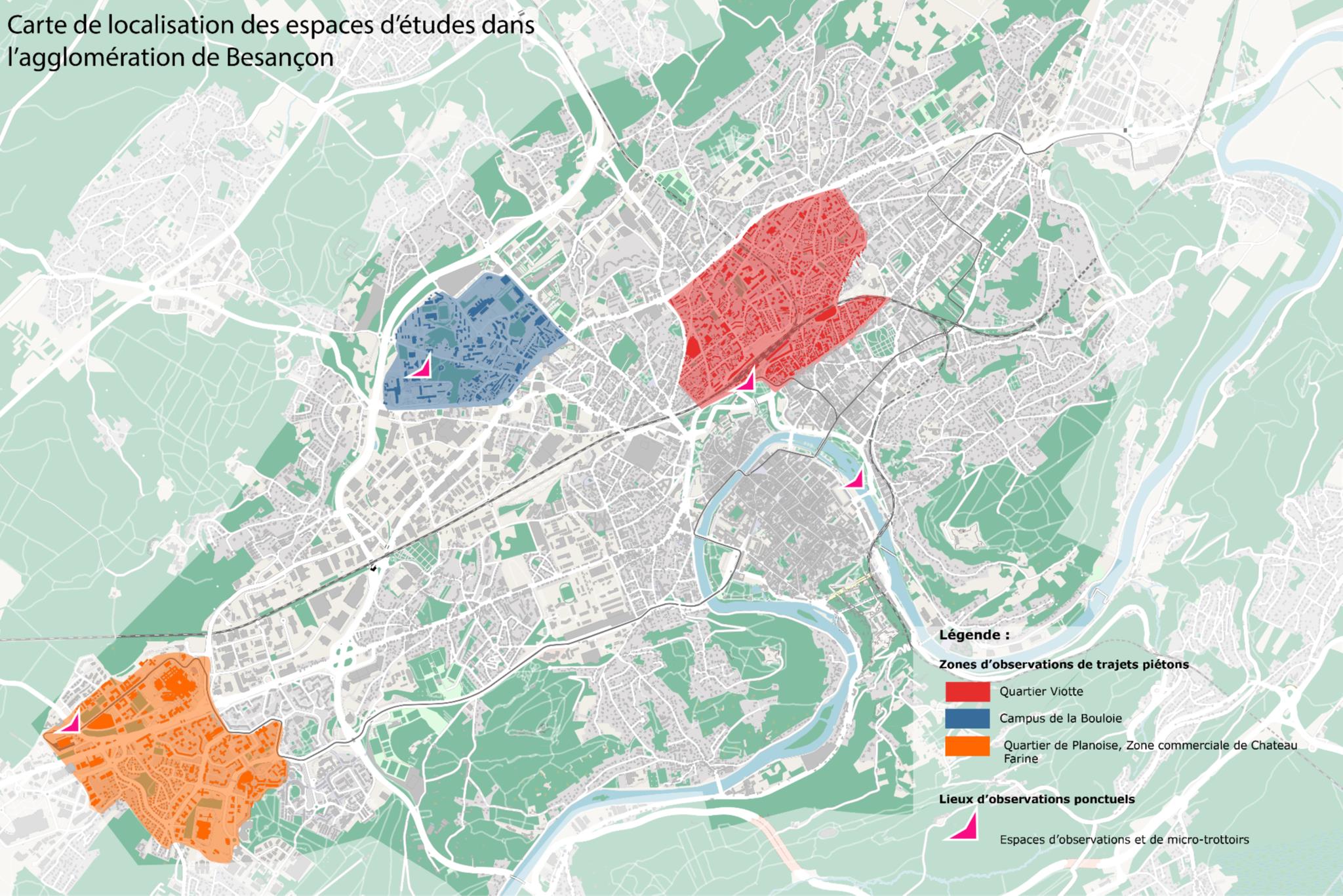
Map of the location of the case study in the agglomeration of Besançon. Created by the student group
Their investigation essentially confirmed the findings from their initial assessment. The city of Besançon is founded upon a centre-periphery model in terms of socio-spatial breaks and in the practice of walking. The centre is characterised by the presence of many facilities, services and offices, it hosts numerous important cultural and educational institutions and has a pedestrian network that promotes walking by restricting motorised vehicles (with the exception of buses, deliveries and residents). Most of its residents exclusively carry out their daily activities there, with the Doubs constituting a symbolic boundary but also a physical limit.
By contrast, outside this centre, and where walking still remains a daily mode of travel, streets are less walkable (the layout promotes motorised traffic and public transport), the quality and presence of infrastructure decrease and distances seem longer. Both in the city centre and in peripheral neighbourhoods, different users struggle to coexist peacefully and the many resulting user conflicts create feelings of insecurity among some pedestrians and users of public space - especially women, children under 15 and people with reduced mobility. This sentiment constitutes the first barrier to walking that is highlighted.
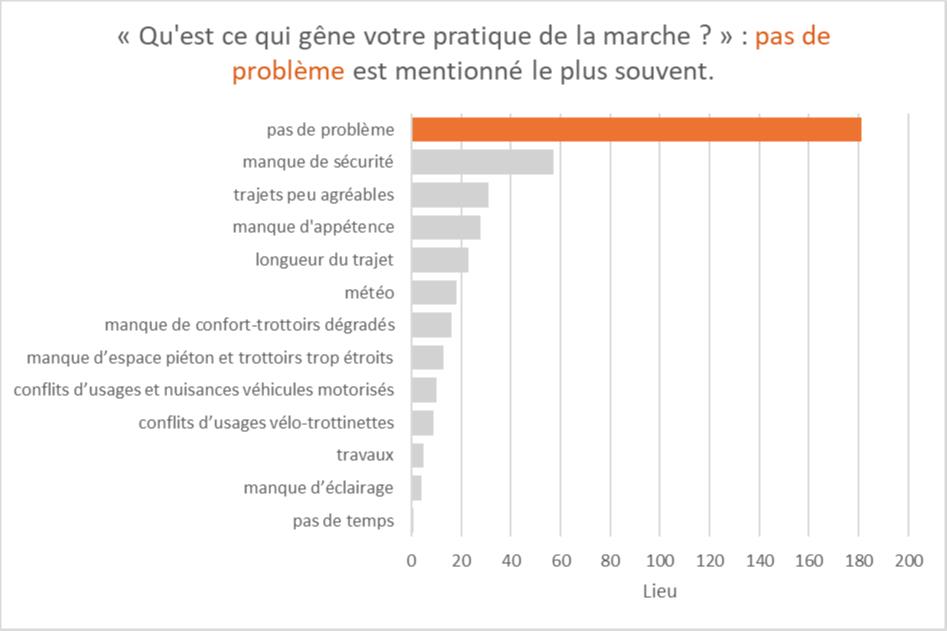
Graph showing problems faced when walking, “no problem” being the most frequent answer
Among the modes sharing the same space, cars are perceived as being the most dangerous: speeding, honking, parking on the sidewalk and a lack of care from motorists for pedestrians are the main issues reported. Pedestrians can sometimes also come into conflict with users of other modes, such as cyclists who ride on the sidewalks when there are no cycle lanes. Womens’ experiences of walking are also worth highlighting: they are the only ones to cite the lack of lighting as a problem; they are more bothered than others by the poor state of sidewalks and the nuisances caused by motorised vehicles; and they sometimes report feeling reluctant to travel on foot. Ultimately, it appears that walking, often considered to be the most universal and accessible mode of transport, is not equally accessible to all.
A second striking observation is that, despite this situation and the challenges that are objectively measured or felt, pedestrians do not have a collective awareness of their common interests (unlike cyclists, for instance). Questions of how to improve walking conditions remain largely overlooked and constitute a blind spot. When respondents were asked about the obstacles they meet when walking and what could be done to improve the situation, they overwhelmingly answered "no problems" and "nothing" respectively.
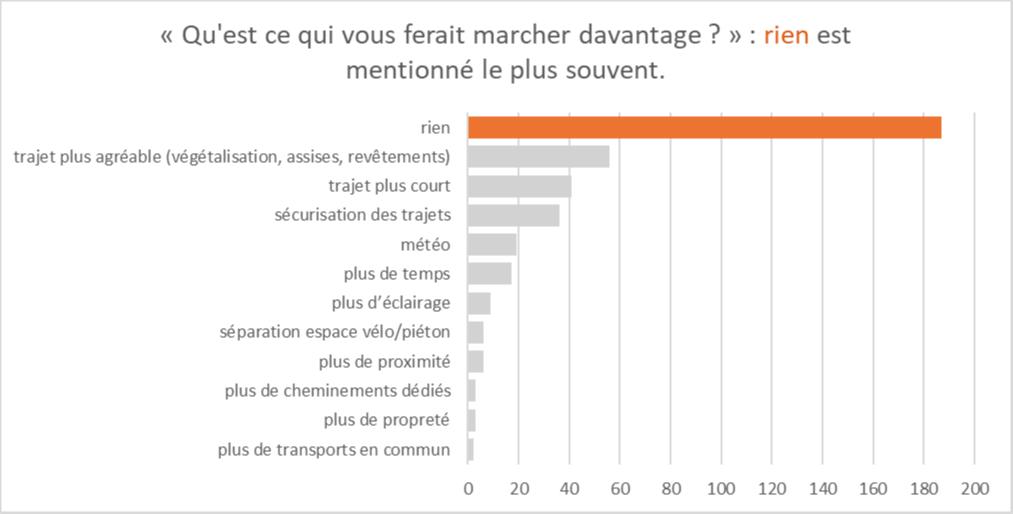
Graph showing what would make the interviewees walk more, “nothing” being the most frequent answer.
A third observation from the trips studied during the field surveys, is that users tend to gravitate around public transport stops and hubs in the three zones outside the city centre that were studied. Walking is mainly used as one stage of intermodality, a means of connecting local spaces with transport, often the first or last mile, to get home, do the shopping... Places with good public transport services on offer see the modal share of walking alone decrease, in favour of intermodal walking. The Besançon-Viotte train station is a good example: as it is particularly well connected to the city centre of Besançon, both on foot and by public transport, it is quite often reached via public transport. Pedestrian travel is therefore strongly linked to other available services there: trams, buses, intercity coaches and TER regional trains.
Finally, the survey confirms that in peripheral and peri-urban areas there is a strong inclination to multimodal walking and using individual cars. This is because of their monofunctionality, low density, lack of local facilities, more diffuse built environment, longer distances, the breaks in pedestrian routes linked to the urban structure or roads and railways, sidewalks that are often in poor condition and under 1.4 metres wide. The Boulois campus, mainly occupied by students, is more conducive to walking - especially intermodal walking - since the university and residential facilities are concentrated within a small area, which makes it easy to travel short distances on foot. It is also well served by public transport, which allows for easy intermodal travel.
Download the full report (in French only)
1 Ipsos pour Keolis (2019), Rapport d’analyse « La pratique de la marche en contexte urbain » https://www.ipsos.com/sites/default/files/ct/news/documents/2019-10/ipsos_transdev_mobilites_en_regions.pdf
2 Ministère de la Transition écologique. « Marcher et pédaler, les pratiques des français » (Rapport issu de l’EMP 2019), (2021)
3 See City-centre, pedestrianization and lifestyles, Mobile Lives Forum, https://forumviesmobiles.org/en/project/12832/city-centre-pedestrianization-and-lifestyles
For the Mobile Lives Forum, mobility is understood as the process of how individuals travel across distances in order to deploy through time and space the activities that make up their lifestyles. These travel practices are embedded in socio-technical systems, produced by transport and communication industries and techniques, and by normative discourses on these practices, with considerable social, environmental and spatial impacts.
En savoir plus xTo cite this publication :
Master’s Degree in Urban Planning and Development at Université Paris 1 (2022-2023) et Jean Debrie (11 January 2023), « Making walking a pillar of the transition to greener and more desirable lifestyles », Préparer la transition mobilitaire. Consulté le 04 May 2025, URL: https://forumviesmobiles.org/en/project/15744/making-walking-pillar-transition-greener-and-more-desirable-lifestyles

Projects by Forum Vies Mobiles are licensed under a Creative Commons Attribution-NonCommercial-ShareAlike 3.0 France License.
Permissions beyond the scope of this license may be available at contact.
Other publications